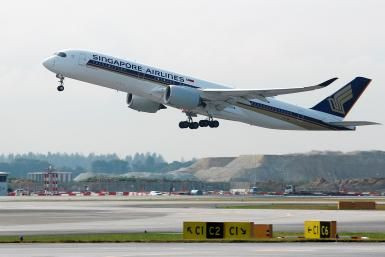Coronavirus Victim: Singapore Airlines Records Its First Ever Annual Loss

KEY POINTS
- In March, the Group enacted salary cuts for its management and unpaid leave for employees
- Singapore Airlines and its regional arm SilkAir have slashed 96% of capacity through the end of June
- The Singaporean Government has vowed to help the national carrier through the crisis
Singapore Airlines recorded the first annual net loss in its 48-year history as the coronavirus pandemic severely dented air travel demand.
Singapore Airline Group, the parent corporation, posted a net loss of $149 million for the 12 months ended Mar. 31, versus a profit $479 million in the prior fiscal year.
The Group lost $514 million in the January-to-March 2020 quarter alone. Revenues in this quarter plunged by $628 million.
The Group noted that it had delivered strong performance through the first three quarters of the fiscal year before the pandemic hit in the fourth quarter.
"Fears about the spread of the virus, as well as global travel restrictions and border controls, led to a collapse in the demand for air travel during the [fourth] quarter,” the Group said. "The prospects for a recovery in international air travel in the months ahead depend upon when border controls and travel restrictions ease. There is no visibility on the timing or trajectory of the recovery at this point, however, as there are few signs of an abatement in the COVID-19 pandemic.”
Singapore Airlines said last week that operating cashflows will remain negative in the June quarter as most of its fleet stays grounded. The airline also expects to incur additional fuel-hedging losses.
The Group also said it has entered into talks with aircraft manufacturers to postpone the delivery on existing aircraft orders.
The national carrier also said it has established an internal task force to review its operations in order to prepare for a recovery in air travel.
"This includes any modifications to our inflight products and end-to-end service delivery to provide additional health and safety assurances to our customers and our crew," the airline said.
In March, the Group enacted salary cuts for its management and unpaid leave for employees.
Singapore Airlines and its regional arm SilkAir have slashed 96% of capacity through the end of June, while its low-cost arm Scoot has cut capacity by 98%.
"The Group will maintain a minimum flight connectivity within its network during this period, while ensuring the flexibility to scale up capacity if there is an uptick in demand," the Group said on Thursday. "In the meantime, the demand for essential goods such as medical supplies, pharmaceuticals and fresh foods still exceeds air freight capacity on many key lanes due to the sharp reduction in bellyhold capacity. This is expected to sustain cargo revenues for the near term. We will also continue to pursue charter opportunities, while closely monitoring for changes in demand."
The Singaporean Government has vowed to help the national carrier through the crisis.
“[Singapore Airlines] has always flown Singapore’s flag high all over the world, and made us proud. We will spare no effort to enable it to do so again,” said Prime Minister Lee Hsien Loong.
Analysts said that while the recovery in the city-state’s aviation and tourism sectors will be slow, they should eventually make a full recovery on the back of government support.
But as Singapore has no domestic aviation market, it is one of the hardest hit Asian airlines.
Former Maybank Kim Eng aviation analyst Mohshin Aziz noted how dependent Singapore Airlines is upon foreign flights.
"[The] bulk of its mainstay passengers' borders [such as Malaysia, Indonesia and India] are closed," he noted. "Therefore, it will be exceptionally hard to obtain healthy load factors anytime soon."
The airline’s majority shareholder, Temasek Holdings (the Singaporean Government's investment arm), agreed in March to underwrite the sale of $6.2 billion of shares and up to $4.4 billion of convertible bonds.
Singapore Airlines said on Thursday it will only access the convertible bonds if necessary and was examining other funding sources.
© Copyright IBTimes 2025. All rights reserved.





















